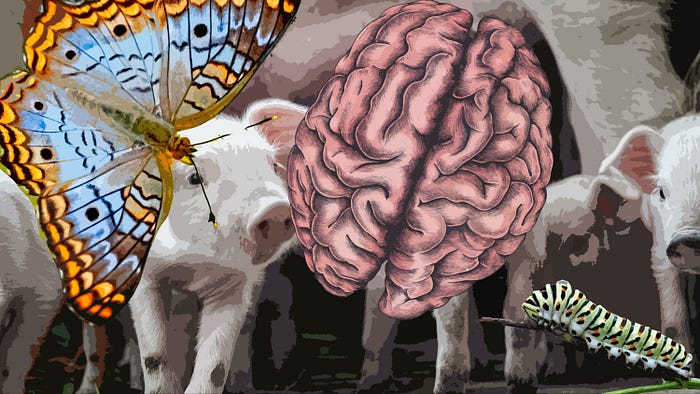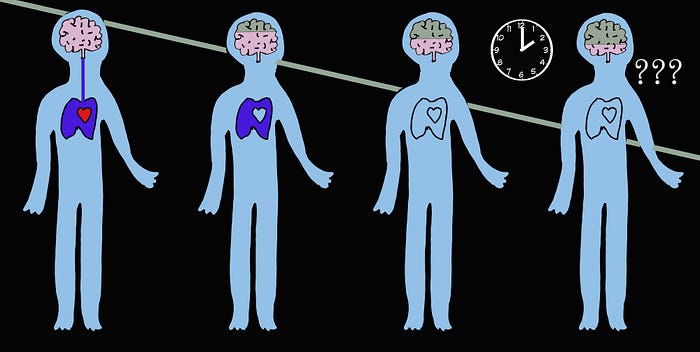

Pig Brains and Butterfly Goo
source link: https://brandy-schillace.medium.com/pig-brains-and-butterfly-goo-9a6160d1993b
Go to the source link to view the article. You can view the picture content, updated content and better typesetting reading experience. If the link is broken, please click the button below to view the snapshot at that time.
Pig Brains and Butterfly Goo
The strange science of life, death, and consciousness

Butterflies and Pig Brains: collage by Brandy Schillace. Photo credits: butterfly by Alfred Schrock, vintage brain by Rawpixel; piglets by Kameron Kincade; swallowtail caterpillar by Stravos Markopoulos.
Thirty-two dead pigs woke up in a lab without their bodies — or, rather, their brain cells did.
The experiment happened in 2019, at the early stages of the pandemic. Researchers went round to a food processing plant and asked to have the discarded heads of slaughtered pigs. Four hours later, they were hooked up to a perfusion device at Yale that fed them a “restorative cocktail” of oxygen and drugs designed to slow or reverse cell death. Soon, researchers found working synapses — the connections between brain cells that allow them to communicate.
The paper appeared in Nature, and the scientists were careful to say that only bits of the brains had come back online, not enough to equal consciousness. All the same, the findings were paradigm-shattering. It means, for one thing, we don’t die all at once.
Your brain — three pounds of gelatinous convolutions and a hundred billion nerves, invisible in its machinations but responsible for all we think, all we do, and all we are — is a greedy little organ. Thirty seconds without oxygenated blood, and you lose consciousness; one minute, and brain cells die; three minutes brings permanent brain damage; and after five, death is imminent.
Or so we’ve always assumed.
What the new study showed, by contrast, is that cell death is a “gradual, stepwise process.” Prof Nenad Sestan, a professor of neuroscience at Yale University, explained that we might have a longer time window after death than we previously thought — and some of those processes can even be “postponed, preserved or even reversed.”

Brain Time: Image credit/creation by Brandy Schillace
The changes were only witnessed at the level of cells and neurons. No brain-wide electrical activity turned up in an electroencephalogram (EEG brain scan), no sense that the pig heads had awareness or perception. They were, basically, still dead brains (and 10 hours after decapitation, it’s no wonder).
The point of this experiment wasn’t to create zombie pigs; the scientists were looking for ways to repair a brain after loss of blood flow and oxygen — such as after a stroke, or when suffering diseases like Alzheimer’s. But the exercise raises some interesting questions about the nature of brains, awareness, and where the ‘self’ resides among the tangled cells of gray matter.
Butterfly Memories
We’ve just been talking about mammals, and intelligent mammals, at that (pigs are quite brainy). But for a moment, let’s look at a simpler structure: butterfly brains. Called the subesophagael ganglion, it is located in the thorax instead of the head. That’s true for most insects; it controls the mouthparts, glands, muscles. Caterpillars have brains of a sort, too. But between the larval and adult stage, caterpillars dissolve their own tissues into a blob of goo.
It’s mind-bending, but inside the pupal case (chrysalis), the many legged crawling worm-like creature releases an enzyme and — well — digests itself. They have to; it isn’t easy turning a worm into a long-limbed, winged, six-legged creature with entirely different anatomical bits.
While in the soup stage, a group of specialized cells (histoblasts) use the goo as raw material to rebuild the body to a new plan. When finished, the adult emerges as an entirely different creature. And yet, brand new research has discovered something very strange indeed. Train a caterpillar to avoid a certain smell, and the metamorphized butterfly will avoid it, too. They remember being caterpillars. That means somehow, the original brain of the caterpillar retains a bit of itself, despite being liquidated. How?
The logical conclusion, and the one most embraced, is that some of the neurons must not get fully dissolved. Bits remain intact, and those bits retain memories formed during those halcyon larval days. How many neurons? We don’t really know, but a “self” of sorts, built from experience and memory, can outlive a process we would have considered utterly destructive.
Pigs, Monkeys, Humans
Let’s return to our disembodied pigs. The heads had not been specially prepared; they were hours dead when the process of revival began. Unlike the chrysalis stage of butterfly development, the tether between living body and brain had been fully severed.
Tissues might be re-animated— in fact, at the Moran Eye Center of Utah, researchers have been able to bring dead eyes back to life, even photo-receptor cells and electrical activity. But a whole brain? It seems the stuff of science fiction. And yet, it has been done.
The first trials happened in the 1970s with monkeys (and some dogs). As with the pigs, the heads were fully removed from their bodies — but with some very important differences. The brains had been super-cooled through perfusion, and this meant the brain cells were kept in nearly suspended animation. They didn’t crave oxygen, and so were prevented from atrophy and death. Then, after re-establishing donor blood flow, scientists allowed the heads to “wake up.” Only this time, they really did wake — they opened their eyes, looked around, gnashed teeth, licked at water, chewed grapes. The now-awake but bodiless brains remembered how to use their mouths, how to make facial expressions. They likely retained other memories of their lives before decapitations (which raised some very heavy and horrific ethical concerns). But one thing seems certain: The experiential self, built of memories, remained.
What does all of this mean for human beings? After all, both the pig and monkey experiments were aimed at learning how to protect, revive, and even re-animate the brains of patients after trauma. There are some who have considered providing cold storage and then new bodies to human beings (notably Dr. Robert White, the surgeon who designed the monkey experiment, and more recently, a neurosurgeon named Sergio Canavero).
But for a moment, let’s step away from the real or imagined benefits of re-animating a dead brain (or transplanting a live one). I want to consider two different, though related, ideas: first, what does it mean to be alive? And second, what does it mean to be us?
We do not have a very conclusive definition of death — even of brain death. What we have are legal understandings and a lot of careful checklists, but at bottom is the notion that brain death cannot be reversed. You (whatever that means) are not coming back. Now, science is having to re-evaluate. Can bringing cells back bring “us” back, too?
We can cultivate stem cells from our own skin in petri dishes these days, but I wouldn’t consider the cells to be “me.” We can even develop brain “organoids” in the lab which can simulate human brain functionality, but they are not sentient. (Yet?) But perhaps the line isn’t between life and death, per se. The pig brains contained living tissue but no memories of organized being. The caterpillar, on the other hand —despite being reduced to little more than chemical ooze — is still in there, is still a singular and unique creature, not just alive, but a life.
Where in the chemical soup of ourselves do we reside? What part of the brain retains the me that knows me, the arbiter of my experience, the caterpillar of my earliest recollection?
Maybe in the future, we will be able to pull patients back from the brink, even after brain death has been established. Maybe we could rehabilitate stroke victims, or even rescue dementia patients from the dimming of their consciousness. With each new step forward, we learn just how much mystery is left to us, and how much more there is to learn.
The future may be a long time coming. But as a mind adrift inside a meat jacket made of 60% water and organ slurry, it gives me courage and hope to know what a butterfly remembers.
Recommend
About Joyk
Aggregate valuable and interesting links.
Joyk means Joy of geeK